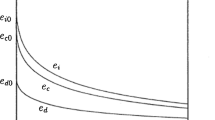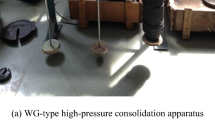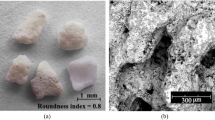Abstract
This paper presents a study on Chlef sand to examine the effect of fines content (Fc), relative density (RD) and initial conditions on the compressibility behavior. The interpretation of the results is based on the concept of the intergranular voids ratio (es) and two hypoplastic parameters model Hs and n for calculation of the maximum voids ratio. The œdometric tests results made in the laboratory show that the fines content transition (Fct) of Chlef sand is in good agreement with the results published in the literature. The results obtained indicate that the higher value of fines fraction (Fc) in the sand cause an increase in the compressibility coefficient (Cc) and the granular compressibility coefficient (Cc-s). Moreover increasing the density from 65 to 80% decreased both coefficients (Cc) and (Cc-s). The samples prepared with the moist tamping method (w = 3%) have compressibility coefficients greater than samples prepared by the dry pluviation method (w = 0%). We have shown that the fines content transition (Fct) depends on the initial state of the samples (relative density, preparation method and maximum void ratio). Finally the granulometric characteristics (D10, D50 and Cu) have a significant effect on compression behavior. Nevertheless a good exponential correlation has been found between the compressibility coefficient (Cc), the granular compressibility coefficient (Cc-s) and the effective diameter (D10), the average diameter (D50) and the uniformity coefficient (Cu).






Adapted from Belkhatir et al. 2010)












Similar content being viewed by others
Abbreviations
- Gs :
-
Specific gravity of sand
- Gf :
-
Specific gravity of fines
- G:
-
Specific gravity of sand-silt mixture
- D10 :
-
Effective diameter
- D50 :
-
Average diameter
- Cc :
-
Compressibility coefficient
- Cc-s :
-
Intergranular compressibility coefficient
- Fc :
-
Fines content
- Fct :
-
Fines content transition
- Cu :
-
Coefficient of uniformity (Cu = D60/D10)
- emax :
-
Maximum void ratio
- emin :
-
Minimum void ratio
- e:
-
Initial void ratio
- es :
-
Intergranular void ratio
- RD:
-
Relative density
- R2 :
-
Coefficient of determination
- σ′:
-
ŒDometer pressure
- WL :
-
Liquid limit
- w:
-
Water content
- ϕ:
-
Internal friction angle
- CMTDP:
-
Cohesion Moist tamping Dry pluviation
References
Amini F, Qi GZ (2000) Liquefaction testing of stratified silty sands. J Geotech Geoenviron Eng Proc ASCE 126(3):208–217
Arab A. (2008). Behaviour soils under monotonic and cyclic loading, Ph.D. dissertation, Universityof Scienceand technology of Oran, Oran, Algeria.
Arab A (2009) Monotonic and cyclic behaviour of silty sand. C R Mecanique 337:621–631
Arab A, Sadek M, Belkhatir M, Shahrour I (2014) Monotonic preloading effect on the liquefaction resistance of Chlef silty sand. Arab J Sci Eng 39:685–694
ASTM D 2435, D 2435M (1997) Standard test method for One dimensional consolidation properties of soil using incremental loading. Annual Book of ASTM Standards, West Conshohocken, PA, p 19428
ASTM D 4253–00 (2002) Standard test method for maximum index density and unit weight of soils using a vibratory table. American Society for Testing and Materials, West Conshohocken, Annual Book of ASTM Standards, pp 1–14
ASTM D 4254–00 (2002) Standard test method for minimum index density and unit weight of soils and calculation of relative density. American Society for Testing and Materials, West Conshohocken, Annual Book of ASTM Standards, pp 1–9
Bauer E (1999) Analysis of shear band bifurcation with a hypoplastic model for a pressure and density sensitive granular material. Mech Mater 31(1999):597–609
Belkhatir M, Arab A, Della N, Schanz T (2012) Experimental study of undrained shear strength of silty sand: effect of fines and gradation. Geotech Geol Eng 30(5):1103–1118
Belkhatir M, Arab A, Della N, Missoum H, Schanz T (2010) Influence of inter-granular void ratio on monotonic and cyclic undrained shear response of sandy soils. C R Mecanique 338:290–303
Belkhatir M, Arab A, Schanz T, Missoum H, Della N (2011) Laboratory study on the liquefaction resistance of sand-silt mixtures: effect of grading characteristics. Granul Matter 13:599–609
Benahmed N, Canou J, Dupla JC (1999) Influence of the initial conditions and the type of loading on the stability of the undrained behavior of loose sand. Twelfth European Conference on Soil Mechanics and Geotechnical Engineering, Amsterdam (2):687–690
Bouri.D, Krim.A, Brahim.A, Arab.A (2019) Shear strength of compacted Chlef sand: effect of water content, fines content and others parameters. Studia geotechnica et mechanica.https://doi.org/10.2478/sgem-2019-0027
Brahim A, Arab A, Belkhatir M, Shahrour I (2016) Laboratory study of geotextiles performance on reinforced sandy soil. J Earth Sci 27(6):1060–1070
Cabalar AF, Haasan RA (2013) Compressional behaviour of various size/shape sand–clay mixtures with different pore fluids. Eng Geol 164:36–49
Castro.G (1969). Liquefaction of sands. PhD thesis, Harvard University, Cambridge, USA
Cfa A, Bernard O, Seth ON, Kwabena OO (2013) The influence of observed clay content on shear strength and compressibility of residual sandy soils. IJERA 3(4):2538–2542
Chang, N.Y., Yey, S.T., Kaufman, L.P. (1982). Liquefaction potential of clean and silty sand. In: Proceedings of 3rd International Earthquake Microzonation Conference, Seattle, USA, pp. 1018–1032.
Cherif Taiba A, Belkhatir M, Arab A, Kadri A, Mahmoudi Y, Schanz T (2015) Experimental study of undrained shear strength of silty sand: effect of fines and gradation. Geotech Geol Eng 30(5):1103–1118
Covert, K. M., Yamamuro, J. A. (1997). Static liquefaction of silty sands. 5th Great Lakes Geotechnical/Geoenvironmental Conference, Michigan, pp. 1–20.
Della N, Arab A, Belkhatir M (2010) A laboratory study of the initial structure and the overconsolidation effects on the undrained monotonic behavior of sandy soil from Chlef region in northern Algeria. Arab J Geosci 4(5–6):983–991
Denine S, Della N, Muhamad DR, Feia S, Canou J, Dupla JC (2016) Effect of geotextile reinforcement on shear strength of sandy soil: laboratory study. Geotech Geol Eng 30(5):1103–1118
Djafar Henni A, Arab A, Belkhatir M, Hamoudi SA, Khelafi H (2013) Undrained behavior of silty sand: effect of the overconsolidation ratio. Arab J Geosci 6(2):297–307
Gudehus G (1996) A comprehensive constitutive equation for granular materials’. Soils Found. 36(1):1–12
Herle I, Gudehus.G, (1999) Determination of parameters of a hypoplastic constitutive model from properties of grain assemblies. Mech Cohes Frict 4:461–486
Konrad JM (1993) Undrained response of loosely compacted sands during monotonic and cyclic compression tests. Geotechnique 43(1):69–89
Kuerbis R, Negussey D, Vaid YP (1988) Effect of gradation and fines content on the undrained response of sand. Geotechnical Special Publication, no. 21, pp. 330–345.
Lade PV, Yamamuro JA (1997) Effects of non-plastic fines on static liquefaction of sands. Can Geotech J 34:918–928
Lupogo K (2012) Effect of fines mineralogy on the oedometric compressional behavior of sandy soils. J Civ Eng Constr Technol 4(7):232–238
Mahmoudi Y, Cherif Taiba A, Belkhatir M, Arab., A., Schanz, T. (2018) Laboratory study on undrained shear behaviour of overconsolidated sand–silt mixtures: effect of the fines content and stress state. Int J Geotech Eng 12(2):118–132
Mašín D (2012) Asymptotic behaviour of granular materials. Granul Matter 14(6):759–774
Monkul, M. M., Ozden, G. (2005). Effect of intergranular void ratio on one-dimensional compression behavior. Proceedings of International Conference on Problematic Soils, International Society of Soil Mechanics and Geotechnical Engineering. Famagusta, Turkish Republic of Northern Cyprus, pp. 1203–1209.
Monkul MM, Onal O (2006) A visual basic program for analyzing oedometer test results and evaluating intergranular void ratio. Comput Geosci Elsevier Sci 32:696–703
Monkul M, Ozden G (2007) Compressional behaviour of clayey sand and transition fines content. Eng Geol 89:195–205
Monkul MM, Ehsan E, Aykut Ş (2016) Influence of coefficient of uniformity and base sand gradation on static liquefaction of loose sands with silt. Soil Dyn Earthq Eng 89:185–197
Monkul MM, Ehsan E, Aykut Ş (2017) Coupled influence of content, gradation and shape characteristics of silts on static liquefaction of loose silty sands. Soil Dyn Earthq Eng 101:12–26
Najser J, Maší D, Bohác J (2012) Numerical modelling of lumpy clay landfill. Int J Numer Anal Meth Geomech 36:17–35
Thevanayagam S (1998) Effect of fines and confining stress on undrained shear strength of silty sands. J Geotech Geoenviron Eng 124(6):479–491
Thevanayagam S, Martin GR (2002) Liquefaction in silty soils-screening and remediation issues. Soil Dyn Earthq Eng 22(9–12):1035–1042
Thevanayagam S, Mohan S (2000) Inter-granular state variables and stress-strain behaviour of silty sands. Geotechnique 50(1):1–23
Thevanayagam S, Shenthan T, Mohan S, Liang J (2002) Undrained fragility of clean sands, silty sands, and sandy silts. J Geotech Geoenviron Eng 128(10):849–859
Vaid YP, Fisher JM, Kuerbis RH (1991) Particle gradation and liquefaction. J Geotech Eng 116(4):698–703
Yin JH (1999) Properties and behaviour of Hong Kong marine deposits with different clay contents. Can Geotech J 36(6):1085–1095
Zlatovic, S., Ishihara, K. (1995). On the influence of non-plastic fines on residual strength. In: Proceedings of the First International Conference on Earthquake Geotechnical Engineering. Tokyo, pp. 14–16.
Acknowledgements
Charles University authors thank to the financial support by the research grant LTACH19028 Inter-Excellence (Inter-Action) of the Czech Ministry of Education, Youth and Sports and by the Center for Geosphere Dynamics (UNCE/SCI/006).
Author information
Authors and Affiliations
Corresponding author
Additional information
Publisher's Note
Springer Nature remains neutral with regard to jurisdictional claims in published maps and institutional affiliations.
Rights and permissions
About this article
Cite this article
Bouri, D.E., Brahimi, A., Krim, A. et al. Compression Behaviour of Chlef Sand and Transition of Fines Content Using Pressure-Dependent Maximum Void Ratios of Sand. Geotech Geol Eng 40, 1675–1692 (2022). https://doi.org/10.1007/s10706-021-01985-8
Received:
Accepted:
Published:
Issue Date:
DOI: https://doi.org/10.1007/s10706-021-01985-8




